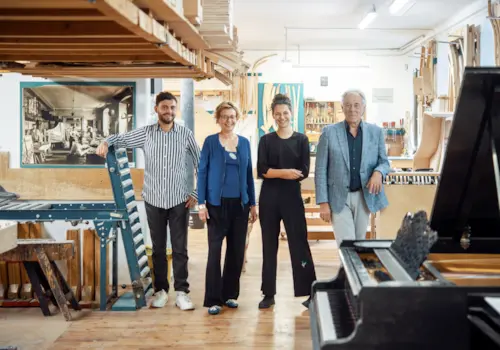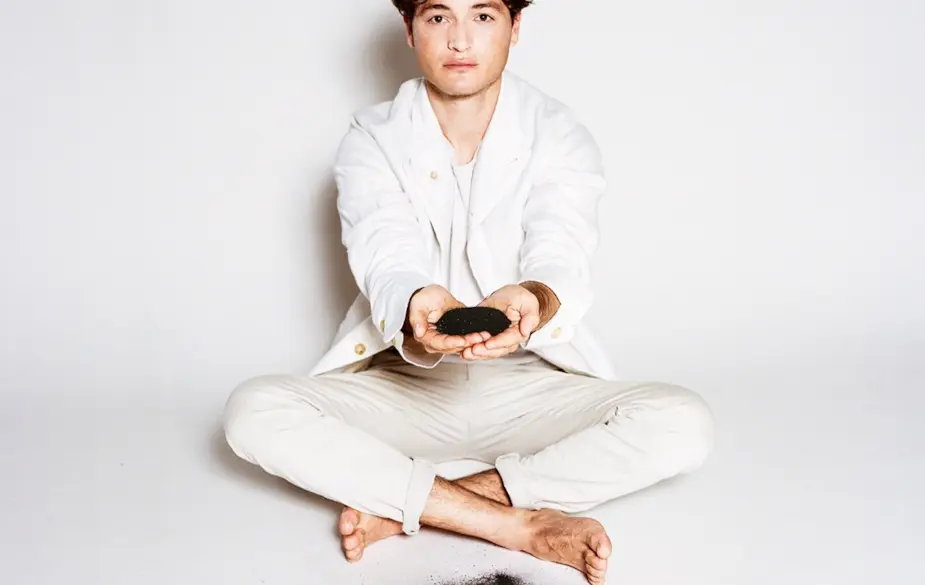04 March 2019
|
Writer Elke Beekman meets the French pianist in his Paris apartment to discuss 'Thirty'
French pianist Thomas Enhco just turned thirty and doesn’t care for musical pigeonholing. He just makes music; pigeonholes exist mainly in other people’s minds. His latest album Thirty attests to this. The first half comprises his own compositions that would grace any jazz stage, while the second half is his first Concerto for Piano and Orchestra (plus encores). We discuss it in his apartment in Paris.
A typical Thomas Enhco concert is a mix of classical, jazz and popular music, as well as his own work. The pieces he performed with his trio at the North Sea Jazz festival could just as easily be encores to his renditions of Ravel or Mozart concertos. And when playing classical music, a jazz interpretation of the notes always lurks around the corner. It is this versatility that prompted record label Sony to approach Enhco last year. “They liked the fact that I play both classical and jazz”, he explains. “They said: ‘Your music has the potential to appeal to music enthusiasts of all genres’. In turn, I was interested in Sony because of their willingness to record a CD of my concerto and release my work outside of France as well.”
Didier Lockwood
The album begins with five compositions for solo piano. The first piece, Joue pour les Anges, is a light-hearted and playful homage to a jazz violinist, Didier Lockwood, who Enhco’s mother, classical singer Caroline Casadesus, married when Enhco was four years old. For over twenty years, Lockwood was not only Enhco's stepfather, but also his musical mentor. Last year, Lockwood suffered a completely unexpected heart attack and sadly died.
A huge loss, says Enhco. “Didier taught me a lot. We shared a home and played together a great deal. Apart from piano, I also play violin and when I was 15 years old, he gave me his violin. He felt that I can sometimes overthink and over-analyse. ‘Thom, forget about all those notes, forget what you've learned and play for the angels!’, he would say. Of course, one plays for oneself and others, but he was referring to the magic that arises once you manage to transcend that. After he had passed away so unexpectedly, I wanted to devote a composition to him.”
In the first bars of Joue pour les Anges, Enhco invokes the romantic sound of Debussy. Then, suddenly, hints of jazz emerge both in the idiom and piano technique, but once the improvisation is over, the piece returns to the atmosphere of the beginning.
Joue pour les Anges is followed by Turning thirty. This piece makes turning thirty sound like a party, which is how Enhco has experienced it. “I'm doing well. I feel less insecure and know what I want. To me, that feeling is part of turning thirty. It is an optimistic, energetic piece.”
'A metaphor for a love song'
Enhco wrote Owl and Tiger like a pop song, complete with verse, chorus and bridge. “It is a metaphor for a love song. It was supposed to be an actual song, but I didn’t manage to write lyrics that conveyed the right feeling.” Following a lyrical beginning, the middle section feels a bit darker, with repeating motives that echo minimal music. The song ends with the familiar starting theme and leaves the impression that the owl and tiger have found each other. When asked which of the two animals he identifies with, he hesitates at first, but then answers: “The tiger.”
Enhco performing 'Owl and Tiger'
Paying homage to water and wind
Apart from music and composition, Enhco does a lot of watersports, including surfing, kite surfing and sailing – preferably on the west coast of France, at ÎIe de Ré, where his family has had a holiday home for years. Prelude Of Wind And Water, as the title suggests, pays homage to water and wind. “Standing on the water, propelled by wind and waves, you get a sense of freedom, but only if you understand the rules. It is a difficult piece to play, especially for the left hand. I have written it down almost in its entirety, except the middle, which leaves some room for improvisation. It could be a classical piece, which is why I've named it a prelude.”
He wrote Looking Back, the conclusion of the series of solo pieces, back in 2010. It breathes a pleasant kind of sadness and would make a great jazz standard. The left-hand keeps supporting the melancholy in a constant motion that is illustrative of Enhco’s music. “The piece was about something which made me very sad at the time, but today I experience it differently. That’s life: time heals and teaches you that painful experiences contribute to who you are today.”
Ensemble Appassionato
After the solo pieces, the door opens to Enhco and close to sixty musicians that make up the Ensemble Appassionato, led by Mathieu Herzog. The piece – Enhco's first Concerto for Piano and Orchestra – was commissioned by Orchestre de Pau Pays de Béarn (premiered in 2017). The concerto sounds like music to a film that has yet to be made, with a lot of room for improvisation. After a stormy beginning, the adventure undergoes an energetic development with surprising twists and small diversions. “The first movement is about childhood. A sense of adventure, energy and fun, play and discovery, the world at your feet”, says Enhco. In the second movement, time is brought to a halt with a gorgeous melody that appeals to the beautiful as well as the fleeting elements of life. You can describe it as romantic, melancholic, nostalgic – take your pick.
But beauty is not all there is to life. In the third and final movement, the orchestra demonstrates what musical force it is capable of. This is the movement where Enhco improvises the most. The intense finale leaves the audience feeling slightly alone. Which is why it is always followed by an encore, including on the album, he says. “I want people to go home feeling good.”
The encores are La Javanaise by Serge Gainsbourg and Orpheus & Eurydice from the opera by Gluck. The fact that the latter is even on the album, is pure serendipity. “We were in the studio and had some time to kill. I found myself in a conversation with the piano tuner. He told me that he was studying Orpheus & Eurydice and asked whether I knew the piece. I said yes, and he asked me to play it. So I took it to the grand piano and played it for him in my own manner. When I had finished, the sound technician Benjamin Ribolet told me he had recorded it. 'Perfect!', he exclaimed."
While composing the Concerto for Piano and Orchestra, Enhco didn’t just think about the music but considered the musicians as well. “The music has to be readable and playable to prevent headaches and save rehearsing time, haha! Sometimes I spent hours just thinking about how to write it in such a way that each musician would end up playing it just like I was hearing it in my mind.”

"We are currently working on a show at La Cigale, one of the largest rock venues in Paris. I want to bring solo piano to that stage."
Fireflies
All in all, 'Thirty' is a good representation of what pianist and composer Thomas Enhco is working on in 2019. Classical, jazz, popular: it's all there. At the same time, this means his music is not so easy to box in, which poses a bit of a problem to some programmers. Even though the solo pieces would work just fine on, for example, a jazz stage, not all programmers are that open-minded, he says. “If jazz comes along, I do not hesitate. For example, I recently performed with jazz guitarist Gilad Hekselman’s ZuperOctave. That was great! But because my own music is no longer labelled ´jazz´, it’s hard to get the attention of jazz programmers. It´s part of the reason why last year I founded my own company, Fireflies, and joined Quartier Libre, a producer of unique cultural productions. We are currently working on a show at La Cigale, one of the largest rock venues in Paris. I want to bring solo piano to that stage. I will be playing my music, as usual, but I want to create an entire world around it. I'm not quite sure how yet, but the date has been set: 17 April 2019.”
Piano and marimba
As if to emphasise his versatility, the premiere of Enhco's first Double Concerto for Piano, Marimba and Orchestra is scheduled just a couple of days after the release of Thirty. It's not a very common combination, but Enhco has formed a duo with marimbist Vassilena Serafimova for the past ten years. And all the versatility aside, there is a common thread to his musical life after all. This emerges at the end of the conversation when he says that he has been picking up the violin more and more in recent years (due to Didier Lockwood's encouragement, among other things). “The beauty of the violin is that you can make it sing. You can maintain a tone, or change it while you’re playing it. The piano is different. I've been studying the way in which the sound of a piano is formed for years now, because eventually I want to make the piano sing as well.”
Luckily he has some time to figure out how, since he only just turned thirty.







